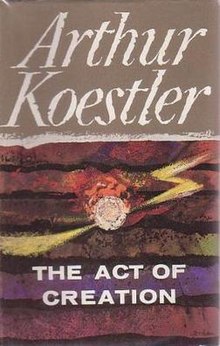Bisociation

First UK edition
|
|
| Author | Arthur Koestler |
|---|---|
| Country | United Kingdom |
| Language | English |
| Subject | Psychology |
| Publisher |
Hutchinson (UK) Macmillan (US) |
|
Publication date
|
1964 |
| Media type | |
| Pages | 751 |
The Act of Creation is a 1964 book by Arthur Koestler. It is a study of the processes of discovery, invention, imagination and creativity in humour, science, and the arts. It lays out Koestler's attempt to develop an elaborate general theory of human creativity.
From describing and comparing many different examples of invention and discovery, Koestler concludes that they all share a common pattern which he terms "bisociation" – a blending of elements drawn from two previously unrelated matrices of thought into a new matrix of meaning by way of a process involving comparison, abstraction and categorisation, analogies and metaphors. He regards many different mental phenomena based on comparison (such as analogies, metaphors, parables, allegories, jokes, identification, role-playing, acting, personification, anthropomorphism etc.), as special cases of "bisociation".
The concept of bisociation has been adopted, generalised and formalised by cognitive linguists Gilles Fauconnier and Mark Turner, who developed it into conceptual blending theory.
The Act of Creation is divided into two books. In the first book, Koestler proposes a global theory of creative activity encompassing humour, scientific inquiry, and art. Koestler's fundamental idea is that any creative act is a bisociation (not mere association) of two (or more) apparently incompatible frames of thought. Employing a spatial metaphor, Koestler calls such frames of thought matrices: "any ability, habit, or skill, any pattern of ordered behaviour governed by a 'code' of fixed rules." Koestler argues that the diverse forms of human creativity all correspond to variations of his model of bisociation.
In jokes and humour, the audience is led to expect a certain outcome compatible with a particular matrix (e.g. the narrative storyline); a punch line, however, replaces the original matrix with an alternative to comic effect. The structure of a joke, then, is essentially that of bait-and-switch. In scientific inquiry, the two matrices are fused into a new larger synthesis. The recognition that two previously disconnected matrices are compatible generates the experience of eureka. Finally, in the arts and in ritual, the two matrices are held in juxtaposition to one another. Observing art is a process of experiencing this juxtaposition, with both matrices sustained.
...
Wikipedia
